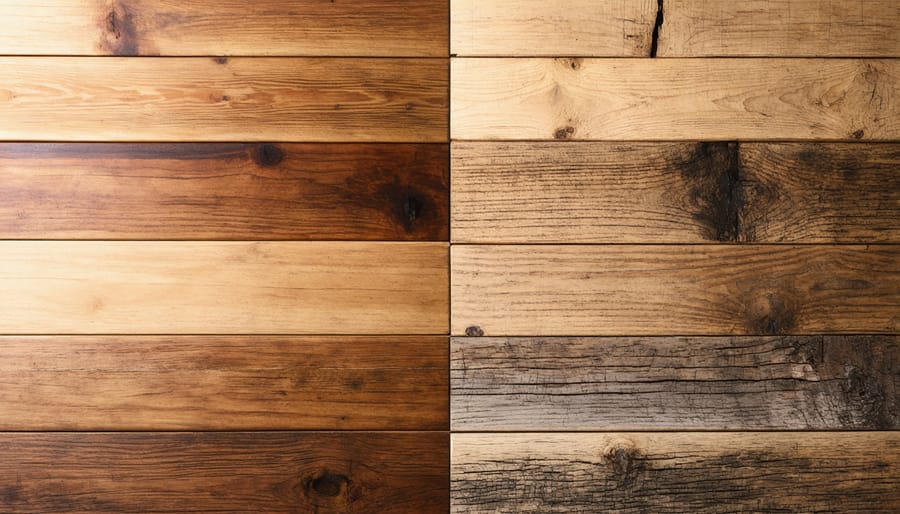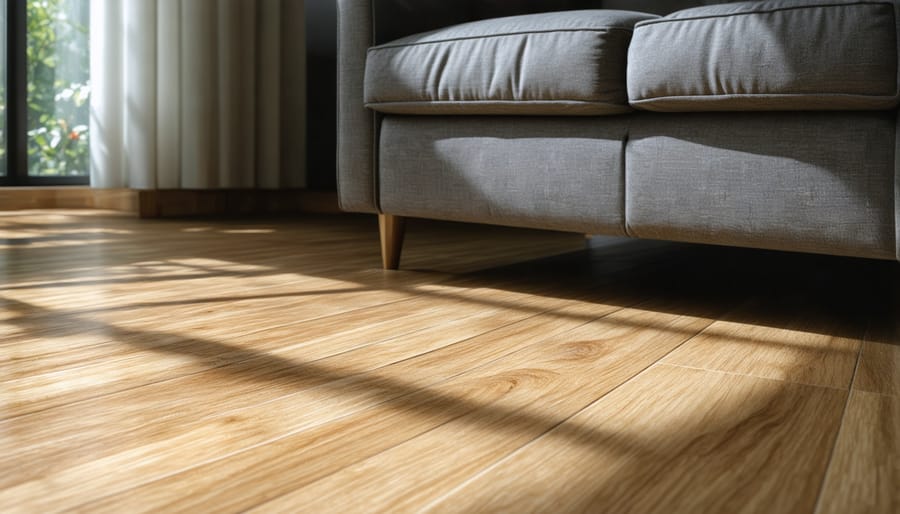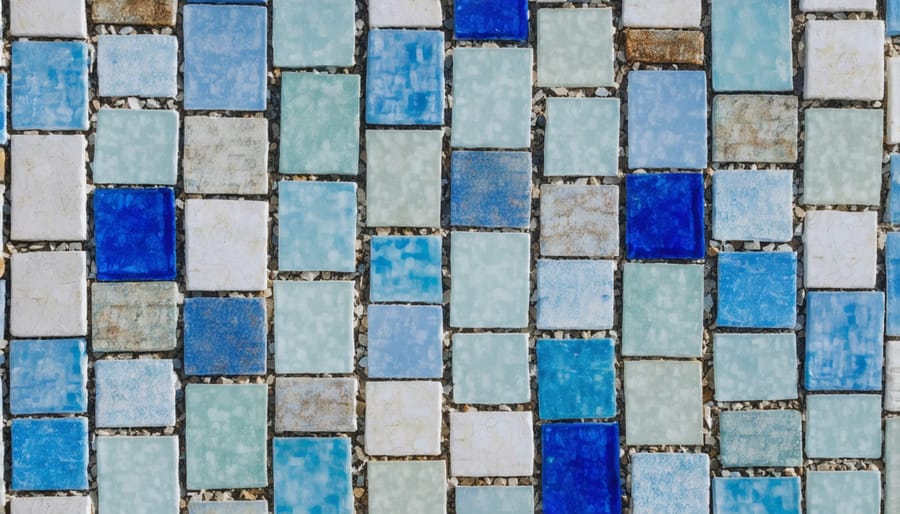
Transform Your Home with These Earth-Friendly Floors That Last
Transform your home into an eco-conscious sanctuary with sustainable flooring choices that combine style, durability, and environmental responsibility. Today’s green flooring options deliver the perfect blend of aesthetic appeal and ecological benefits, from rapidly renewable bamboo that outperforms traditional hardwood to reclaimed materials that tell unique stories through their preserved character.
The flooring beneath your feet significantly impacts both your living space and the planet’s health. Modern eco-friendly options have evolved far beyond basic recycled materials, now offering sophisticated solutions that rival conventional flooring in both performance and design versatility. Whether you’re renovating a single room or planning a whole-house upgrade, choosing sustainable flooring means investing in your home’s future while reducing its environmental footprint.
From cork’s natural sound-dampening properties to certified sustainable hardwoods that support responsible forestry, today’s green flooring alternatives prove that environmental consciousness doesn’t mean compromising on quality or style. These materials not only minimize environmental impact during production but also contribute to healthier indoor air quality and often require less intensive maintenance over their lifecycle.
Sustainable Hardwood Solutions

FSC-Certified Wood Flooring
FSC-certified wood flooring stands as a cornerstone among eco-friendly home features, offering beauty and environmental responsibility in one package. The Forest Stewardship Council (FSC) certification ensures that your flooring comes from responsibly managed forests where trees are replanted and local ecosystems are protected. This means for every tree harvested, new ones are planted to maintain forest health and biodiversity.
When you choose FSC-certified flooring, you’re supporting sustainable forestry practices that protect wildlife habitats and support local communities. These woods are harvested using methods that minimize environmental impact and ensure forest regeneration. Popular options include oak, maple, and bamboo, each offering unique grain patterns and durability levels.
Look for the FSC logo when shopping – it’s your guarantee that the wood meets strict environmental and social standards. While these floors might cost slightly more upfront, they often last longer and add significant value to your home while giving you peace of mind about your environmental impact.
Reclaimed Wood: Beauty with History
Reclaimed wood flooring tells a unique story in every plank, combining environmental responsibility with timeless beauty. Sourced from old barns, factories, and historic buildings, these rescued materials bring character and charm while preventing further deforestation. Each board carries distinctive markings, nail holes, and natural wear patterns that create an authentic, lived-in aesthetic impossible to replicate with new materials.
Beyond its visual appeal, reclaimed wood is often more stable and durable than virgin timber, thanks to its age and natural seasoning process. The wood comes from old-growth forests, featuring tighter grain patterns and superior strength compared to newer wood harvested from younger trees.
Common sources include dismantled barn beams, industrial building timbers, wine casks, and old shipping containers. While typically more expensive than new wood flooring, the investment pays off in both environmental impact and unique character. Many suppliers now offer certified reclaimed wood, ensuring authenticity and sustainable sourcing practices.
For the best results, work with reputable dealers who can verify the wood’s origin and properly prepare it for flooring use.
Bamboo: The Fast-Growing Wonder Material
Strand-Woven vs. Traditional Bamboo
When it comes to bamboo flooring, you’ll encounter two main types: strand-woven and traditional. Strand-woven bamboo is engineered by compressing bamboo fibers under extreme pressure and heat, creating an incredibly dense and durable material that’s actually harder than most hardwoods. This process results in flooring that’s about twice as hard as traditional bamboo, making it ideal for high-traffic areas and homes with pets.
Traditional bamboo flooring comes in either horizontal or vertical construction. Horizontal bamboo shows the characteristic bamboo nodes and creates a more natural, authentic look. Vertical bamboo offers a more uniform appearance with its linear grain pattern. While traditional bamboo is still plenty durable, it’s generally not as hard-wearing as strand-woven varieties.
Cost-wise, strand-woven bamboo typically commands a higher price point due to its superior durability and more complex manufacturing process. However, both types offer excellent eco-friendly credentials, as bamboo reaches maturity in just 5-7 years, compared to decades for traditional hardwood trees.

Installation and Maintenance Tips
Maintaining eco-friendly flooring, particularly bamboo, is straightforward when you follow the right care routine. Start by placing protective pads under furniture legs to prevent scratches and dents. Use doormats at entrances to reduce dirt and debris tracking, which can wear down the flooring over time.
For daily cleaning, sweep or vacuum with a soft-bristled attachment to remove loose dirt. When mopping, use a damp (not wet) microfiber mop with a pH-neutral cleaner specifically designed for bamboo or hardwood floors. Avoid steam mops, as excessive moisture can damage the flooring.
Address spills immediately by blotting them with a clean, dry cloth. Never let water pool on the surface, as bamboo can be sensitive to moisture. For stubborn stains, use a cleaning solution recommended by your flooring manufacturer.
To maintain the floor’s appearance, consider recoating the surface every 3-5 years, depending on wear. Watch for signs of wear or damage, and address issues promptly to extend your flooring’s lifespan. Keep indoor humidity levels between 35-55% to prevent warping or cracking.
Cork: Nature’s Cushioned Floor
Comfort and Sound Absorption
Cork flooring stands out as a remarkable choice for homeowners seeking both comfort and acoustic benefits in their living spaces. The natural cellular structure of cork creates tiny air pockets that act as natural shock absorbers, making it incredibly comfortable to walk and stand on for extended periods. This springy quality is particularly beneficial in kitchens or other areas where you spend lots of time on your feet.
What truly sets cork apart is its exceptional sound-dampening capabilities. The same cellular structure that provides comfort also absorbs impact noise and reduces sound transmission between floors. This makes it an excellent choice for multi-story homes, apartment buildings, or rooms where noise reduction is a priority, such as home offices or children’s playrooms.
The thermal insulation properties of cork add another layer of comfort, helping maintain room temperature and potentially reducing energy costs. Whether you’re padding around barefoot on a cold morning or hosting a lively gathering, cork flooring provides a warm, quiet, and cushioned surface that enhances the overall comfort of your living space.
Durability and Water Resistance
When it comes to eco-friendly flooring, durability and water resistance are crucial factors that determine where and how you can use different materials. Cork and bamboo flooring offer moderate water resistance and can withstand daily wear, though they should be sealed properly for maximum protection. Cork, in particular, bounces back from minor dents and provides natural moisture resistance, making it suitable for kitchens and bathrooms when properly treated.
Reclaimed wood varies in durability depending on the species but generally performs well with proper maintenance. However, it requires careful sealing to prevent water damage. Natural linoleum, made from renewable materials like linseed oil and cork dust, offers excellent water resistance and can last up to 40 years when properly maintained.
For areas prone to moisture, polished concrete stands out as an exceptionally durable and water-resistant option. It can withstand heavy traffic and moisture exposure without compromising its integrity. Glass tiles, another sustainable choice, are completely waterproof and incredibly durable, perfect for wet areas like bathrooms and kitchens. Remember that proper installation and regular maintenance are key to maximizing the lifespan of any eco-friendly flooring option.
Recycled and Natural Materials
Recycled Glass and Rubber Tiles
Transform your space with innovative flooring made from materials that might otherwise end up in landfills. Recycled glass tiles create stunning, light-catching surfaces that bring a unique sparkle to any room. These tiles are crafted from post-consumer glass products, such as bottles and windows, which are crushed, melted, and reformed into durable flooring options. Available in a rainbow of colors and patterns, recycled glass tiles are perfect for bathrooms, kitchens, and statement walls.
Rubber tiles, often made from recycled car tires and other rubber products, offer another sustainable choice that’s gaining popularity. These tiles are incredibly resilient, comfortable underfoot, and provide excellent sound insulation. They’re particularly well-suited for home gyms, playrooms, and high-traffic areas where durability is crucial.
Both options are remarkably easy to maintain and clean. Glass tiles are non-porous, making them resistant to stains and bacteria, while rubber tiles can be simply swept and mopped with mild cleaning solutions. These materials also score high on the sustainability scale – each square foot of recycled flooring keeps significant amounts of waste out of landfills.
Installation is straightforward for both materials, though glass tiles typically require professional installation for the best results. Rubber tiles, however, are often available in interlocking formats that make them perfect for DIY projects. Both options are excellent choices for those seeking to combine environmental responsibility with practical, attractive flooring solutions.

Natural Stone and Concrete
Natural stone and concrete flooring options offer a perfect blend of sustainability and timeless beauty. These mineral-based materials are incredibly durable, often lasting for generations, which significantly reduces the need for replacement and minimizes environmental impact over time.
Natural stone, such as slate, limestone, and travertine, requires minimal processing compared to manufactured materials. When sourced locally, these materials have a lower carbon footprint due to reduced transportation needs. Many stone varieties are also recyclable and can be repurposed when eventually removed, making them an environmentally conscious choice.
Concrete flooring has emerged as a surprisingly eco-friendly option, especially when made with recycled aggregates or industrial byproducts like fly ash. Modern concrete floors can be stained, polished, or stamped to create stunning designs that rival more resource-intensive flooring materials. The thermal mass properties of both stone and concrete make them excellent choices for passive solar heating and cooling, potentially reducing your home’s energy consumption.
For enhanced sustainability, consider salvaged stone or reclaimed concrete pavers. These materials not only prevent waste but also add unique character to your space. When selecting sealants and finishes, opt for low-VOC products to maintain indoor air quality. Both stone and concrete floors are naturally hypoallergenic and don’t harbor dust or allergens, contributing to a healthier indoor environment.
Remember that proper installation and maintenance are crucial for maximizing the longevity of these materials. While the initial investment might be higher, their durability and minimal maintenance requirements make them cost-effective in the long run.
Smart Installation and Maintenance
Low-VOC Adhesives and Finishes
When installing your eco-friendly flooring, it’s crucial to consider the adhesives and finishes you’ll use, as these materials can significantly impact indoor air quality. Traditional adhesives and finishes often contain high levels of volatile organic compounds (VOCs), which can release harmful chemicals into your home for years after installation.
Fortunately, there’s a growing selection of eco-friendly finishes and adhesives that maintain high performance while keeping your indoor air clean. Look for products labeled as zero-VOC or low-VOC, which typically contain less than 50 grams of VOCs per liter. Water-based polyurethane adhesives and natural oil finishes are excellent choices that offer durability without the toxic fumes.
For DIY installations, many manufacturers now offer peel-and-stick options or click-lock systems that eliminate the need for adhesives altogether. If you must use adhesives, choose those certified by organizations like GreenGuard or FloorScore to ensure they meet strict environmental and health standards. These safer alternatives protect both your family’s health and the planet while delivering beautiful, lasting results.
Green Cleaning Solutions
Maintaining your eco-friendly flooring doesn’t have to mean compromising your environmental values. Skip the harsh chemicals and opt for natural cleaning solutions that are just as effective. A simple mixture of warm water and white vinegar works wonders on most sustainable flooring materials, cutting through dirt while being gentle on surfaces.
For wooden floors, try a solution of warm water with a few drops of castile soap, which is biodegradable and plant-based. Tea tree oil can be added for its natural antibacterial properties. For bamboo and cork flooring, less is more – a damp microfiber mop with plain water is often sufficient.
Baking soda makes an excellent natural scrub for tough stains, while lemon juice can help brighten and deodorize naturally. Always test cleaning solutions on a small, inconspicuous area first. Remember to use reusable mops and cloths instead of disposable wipes, and opt for spray bottles you can refill rather than single-use cleaning products.
Regular maintenance with these green solutions not only protects your investment but also maintains indoor air quality and reduces your environmental impact.
Choosing eco-friendly flooring isn’t just a trend – it’s a meaningful step toward creating a more sustainable future while enhancing your living space. Throughout this guide, we’ve explored various sustainable flooring options that combine environmental responsibility with style and durability. From the timeless appeal of bamboo to the innovative cork solutions and reclaimed wood options, there’s an eco-friendly floor for every home and budget.
Remember that the long-term benefits of sustainable flooring extend far beyond their aesthetic appeal. These materials reduce environmental impact, improve indoor air quality, and often outlast conventional alternatives when properly maintained. By choosing certified sustainable products and working with reputable suppliers, you’re not only investing in your home but also contributing to forest conservation and responsible manufacturing practices.
Whether you’re renovating a single room or planning a whole-house upgrade, let sustainability guide your flooring decisions. Consider factors like durability, maintenance requirements, and local availability alongside environmental impact. With the wide range of eco-friendly options available today, you don’t have to compromise between beauty, functionality, and environmental responsibility. Make your next flooring project a step toward a greener future while creating a beautiful, healthy living space for years to come.
